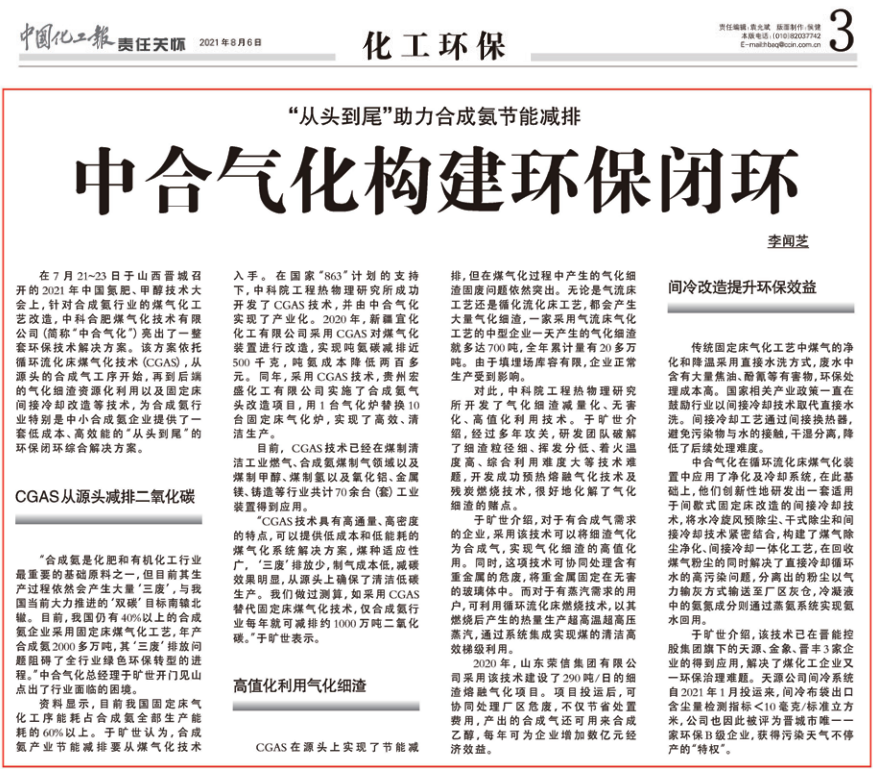
Source: China Chemical Industry News
“從頭到尾”助力合成氨節能減排

At the 2021 China Nitrogen Fertilizer and Methanol Technology Conference held from July 21 to 23 in Jincheng, Shanxi, CAS Hefei Coal Gasification Technology Co., Ltd. (“ZHGAS”) unveiled a comprehensive environmental technology solution for upgrading coal gasification processes in the synthetic ammonia industry. Based on circulating fluidized bed gasification technology (CGAS), the solution covers the entire production chain—from syngas generation to downstream utilization of gasification fine slag and indirect cooling upgrades for fixed-bed systems—offering small and medium-sized synthetic ammonia producers a cost-effective, high-efficiency, eco-friendly closed-loop system.
“Synthetic ammonia is a crucial raw material for fertilizer and organic chemical industries, yet its production still generates large amounts of ‘three wastes’ (waste gas, water, and solids), which conflicts with China’s carbon neutrality goals,” said Yu Kuangshi, General Manager of ZHGAS. Currently, over 40% of synthetic ammonia plants in China still use fixed-bed coal gasification, producing more than 20 million tons of ammonia annually, with significant environmental impacts hindering the industry’s green transformation.
Data shows that fixed-bed gasification accounts for over 60% of the total energy consumption in synthetic ammonia production. Yu emphasized that energy saving and emission reduction in the ammonia industry must start from coal gasification technology. Supported by China’s “863” program, the Institute of Engineering Thermophysics of the Chinese Academy of Sciences developed CGAS technology, which ZHGAS then industrialized.
In 2020, Xinjiang Yihua Chemical Co., Ltd. upgraded its gasification unit with CGAS, reducing carbon emissions by nearly 500 kg per ton of ammonia and cutting costs by over 200 RMB per ton. The same year, Guizhou Hongsheng Chemical Co., Ltd. replaced 10 fixed-bed gasifiers with a single CGAS gasifier, achieving highly efficient and clean ammonia production.
To date, CGAS has been applied in more than 70 industrial installations across sectors including coal-based clean industrial gas, synthetic ammonia, coal-to-methanol, coal-to-hydrogen, alumina, magnesium metal, and foundry industries.
“CGAS features high throughput and density, broad coal adaptability, low emissions, and low gas production costs, effectively ensuring clean, low-carbon production from the start,” Yu explained. “Replacing fixed-bed gasification with CGAS in synthetic ammonia alone could reduce CO? emissions by about 10 million tons annually.”
While CGAS reduces emissions at the source, managing the solid waste of fine gasification slag remains challenging. Both entrained flow and circulating fluidized bed gasification produce large amounts of fine slag—for example, a medium-sized plant using entrained flow technology can generate up to 700 tons daily, totaling over 200,000 tons annually. Limited landfill capacity constrains normal production.
To address this, the Institute of Engineering Thermophysics developed technologies for reducing, detoxifying, and high-value utilization of fine slag. After years of research, the team overcame challenges such as fine particle size, low volatility, high ignition temperature, and difficult comprehensive use, successfully developing preheated molten slag gasification and residual carbon combustion technologies.
For enterprises requiring syngas, this technology gasifies the fine slag into synthetic gas, enabling high-value utilization. It can also treat hazardous waste containing heavy metals by fixing metals into harmless glassy materials. For steam users, circulating fluidized bed combustion technology converts slag into ultra-high temperature and pressure steam, enabling clean and efficient multi-stage coal utilization through system integration.
In 2020, Shandong Rongxin Group built a 290-ton/day fine slag molten gasification project using this technology. The project also treats hazardous waste on site, saving disposal costs and producing syngas for ethanol synthesis, generating hundreds of millions of RMB in annual economic benefits.
Traditional fixed-bed gasification cools and purifies syngas by direct water washing, producing wastewater containing harmful substances like tar and phenol, with high treatment costs. National policies encourage replacing this with indirect cooling technology, which uses heat exchangers to separate contaminants from water, reducing downstream treatment difficulty.
ZHGAS applied an integrated purification and cooling system in circulating fluidized bed gasifiers, and innovatively developed an indirect cooling technology for upgrading intermittent fixed-bed gasifiers. Combining water-cooled cyclone pre-dust removal, dry dust removal, and indirect cooling, this integrated process recovers coal dust and eliminates pollution from direct cooling water. Collected dust is pneumatically transported to ash silos, while ammonia nitrogen in condensate is recycled via an ammonia recovery system.
Since January 2021, this technology has been implemented at three subsidiaries of Jinneng Holding Group—Tianyuan, Jinxiang, and Jinfeng—effectively solving a key environmental challenge for coal chemical enterprises. Tianyuan’s indirect cooling system achieves dust emission levels below 10 mg/Nm3, earning the company the distinction as Jincheng’s only environmental-grade B enterprise, with the privilege to continue production during pollution alerts.